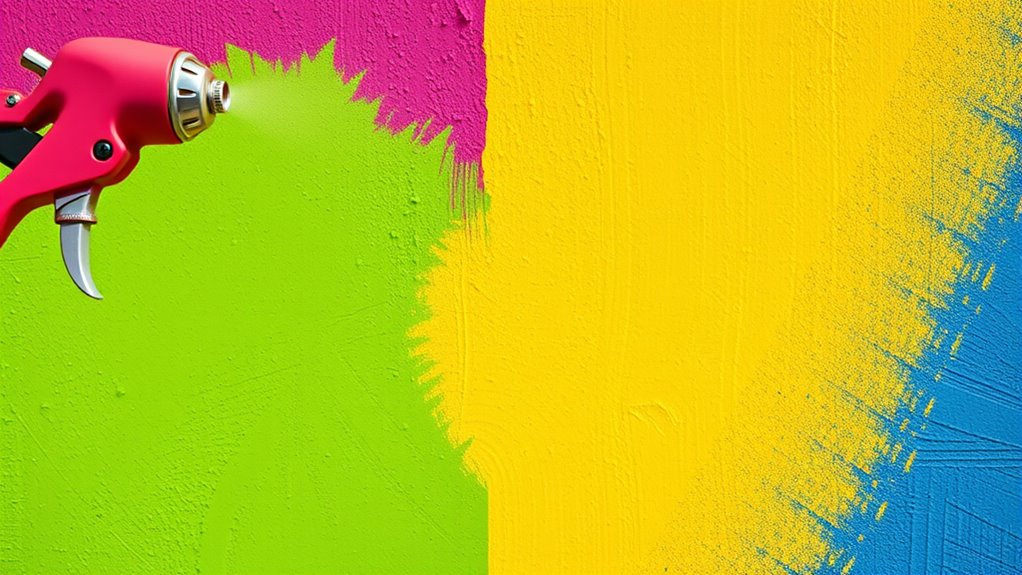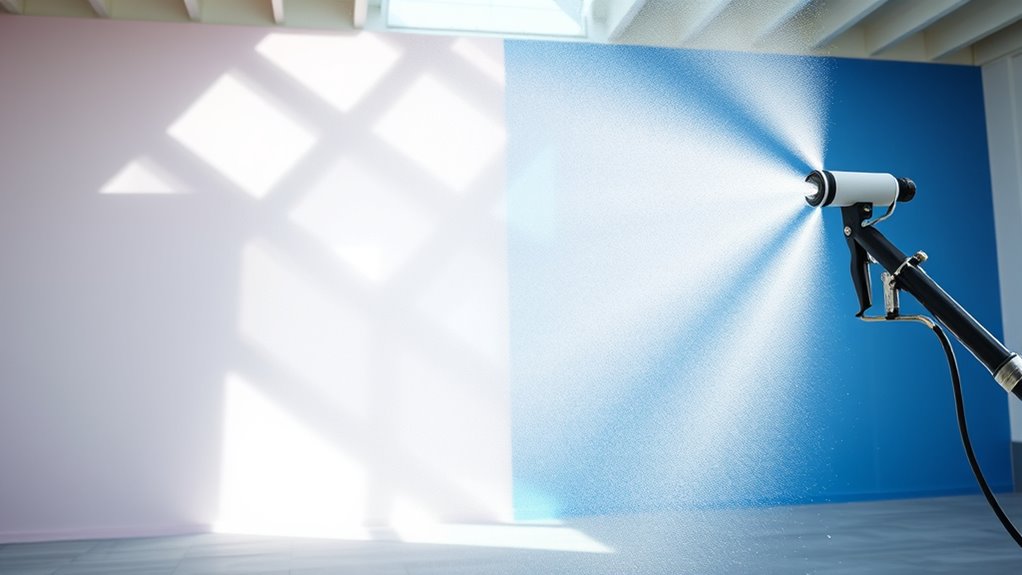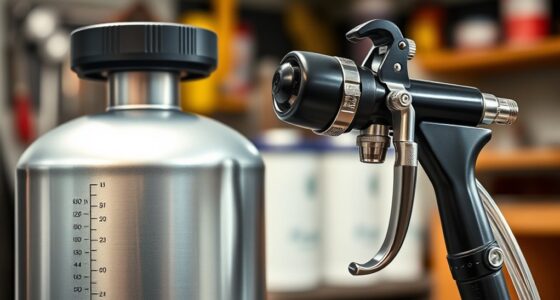Paint sprayers often use more paint than rollers because of overspray and bounce-back, especially if you’re not careful. While sprayers can cover large areas quickly, they tend to waste paint unless you control the spray pattern well. Rollers usually apply less paint and offer more control, reducing waste. However, your technique impacts how much paint is used overall. Keep exploring, and you’ll discover tips to optimize your paint consumption with either method.
Key Takeaways
- Paint sprayers often use more paint due to overspray and bounce-back without proper technique.
- Rollers generally apply paint more efficiently, resulting in less waste and lower paint consumption.
- Proper spraying technique can reduce paint use, but inexperienced users tend to waste more paint.
- Sprayers cover large areas quickly but may require additional coats, increasing overall paint use.
- Overall, spray painting can use more paint than rollers if not carefully controlled.

Are paint sprayers or rollers better for your next project? That’s a common question, especially when contemplating whether paint sprayers use more paint than rollers. The truth is, it depends on how you apply the paint and your technique. When you opt for a roller, you typically use less paint because you’re applying it directly onto the surface with a controlled, even pressure. Rollers are great for achieving a smooth finish quickly, and because you can control the amount of paint on the roller, you minimize waste. Plus, with proper brush techniques—like loading the roller adequately and rolling in a consistent pattern—you ensure even coverage without excess paint dripping or pooling. This can actually help conserve paint and reduce over-application.
In contrast, paint sprayers tend to use more paint, but not necessarily because they’re wasteful. Sprayers atomize the paint into tiny droplets, allowing for fast coverage over large areas. However, this method can lead to overspray and bounce-back, which means some paint lands outside your intended surface. As a result, you might end up using more paint than necessary, especially if you’re not careful with your spray pattern or distance. But if you’re experienced with spray techniques, you can minimize paint waste by maintaining the proper distance and using consistent, overlapping strokes. This helps ensure that you’re not applying excess paint and that the coverage remains even.
Another factor to contemplate is how paint dries after application. When using a roller, the paint tends to dry faster and more evenly because of the controlled, thicker layer you apply in each pass. Proper brush techniques can help you avoid uneven patches or streaks, ensuring a smooth surface once the paint dries. With a sprayer, the paint dries quickly due to the fine mist, but multiple coats may be needed to achieve the same depth of color and finish as a roller. This can lead to more paint use over time, especially if you’re applying light coats or if the paint is thin. Additionally, the cost-effectiveness of each method varies depending on project scope and technique, influencing overall paint consumption.
In the end, whether you use a sprayer or roller, your total paint consumption hinges on your application method and technique. Rollers are often more economical in paint use, especially for smaller projects or when applying solid, uniform coats. Sprayers, while faster, can use more paint if not managed carefully. So, it’s essential to weigh your skill level, the project size, and your desired finish when choosing between the two.
Frequently Asked Questions
How Much Faster Are Paint Sprayers Compared to Rollers?
When comparing paint application speed, paint sprayers are considerably faster than rollers, making them ideal for large projects. They cover surfaces quickly, reducing your overall time and effort. In an efficiency comparison, sprayers deliver a smooth, even coat faster, especially on complex surfaces. While rollers may be better for small areas or detailed work, sprayers are your go-to for rapid, large-scale coverage, saving you valuable time.
Can Paint Sprayers Be Used for Detailed or Small-Area Work?
You might think paint sprayers are too messy for detailed work, but ironically, they can be your best tool for precision detailing. Unlike brushes, which require delicate brush techniques, sprayers can tackle small areas quickly and evenly. For intricate designs or tight spots, a steady hand and careful control make sprayers surprisingly effective. So, don’t dismiss them for detailed or small-area work—they might surprise you with their efficiency and accuracy.
Do Paint Sprayers Require More Cleanup Time Than Rollers?
You’ll find that paint sprayers generally require more cleanup time than rollers because of equipment maintenance. Sprayers involve more parts and can splatter paint, making thorough cleaning essential to prevent clogs and ensure longevity. While this may take extra effort, it reduces your environmental impact by minimizing waste. Proper cleanup helps keep your equipment in good shape and reduces the need for frequent replacements, making it a worthwhile investment.
Are Paint Sprayers Suitable for All Types of Paint?
Paint sprayers are suitable for many types of paint, but their effectiveness depends on paint consistency. Thinner paints work best, providing smooth application and minimizing clogging. Sprayers offer great application versatility, especially for large surfaces or detailed work. However, thicker paints may need thinning, and some specialty paints might not be compatible. Always check manufacturer guidelines to guarantee your paint fits the sprayer for ideal results.
How Does Paint Wastage Compare Between Sprayers and Rollers?
Imagine you’re pouring paint into a bucket—now, picture that paint spilling everywhere. Paint sprayers often create more paint overspray and material runoff, leading to higher wastage. Rollers, on the other hand, kiss the surface more gently, using paint more efficiently. So, if you’re aiming to minimize waste, rollers tend to save more paint, while sprayers might leave some behind in the chaos of overspray and runoff.
Conclusion
So, do paint sprayers use more paint than rollers? Not necessarily. While sprayers can sometimes seem like they waste paint due to overspray, they actually deliver a more even coat quickly, often requiring less paint overall. Rollers might use less paint per stroke but can need multiple coats for full coverage. Ultimately, it depends on your project and technique. Try both methods to see which works best for you—save paint and time in the process!
Franz came aboard the Paint Sprayer Zone team with a background in both journalism and home renovation. His articulate writing style, combined with a passion for DIY projects, makes him an invaluable asset. Franz has a knack for breaking down technical jargon into easy-to-understand content, ensuring that even the most novice of readers can grasp the complexities of paint sprayers.










